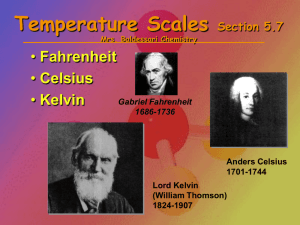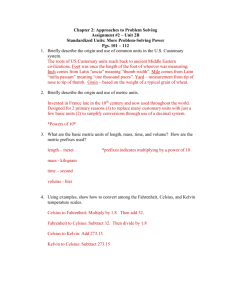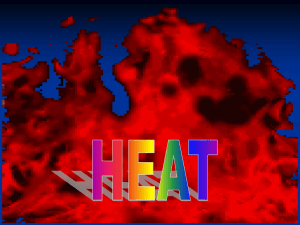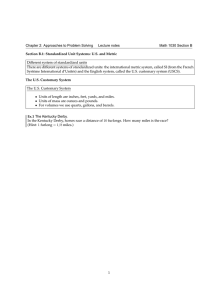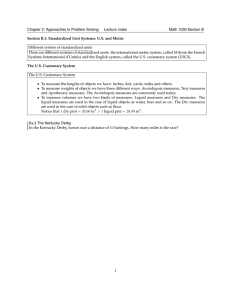Measurement and the Metric System
advertisement
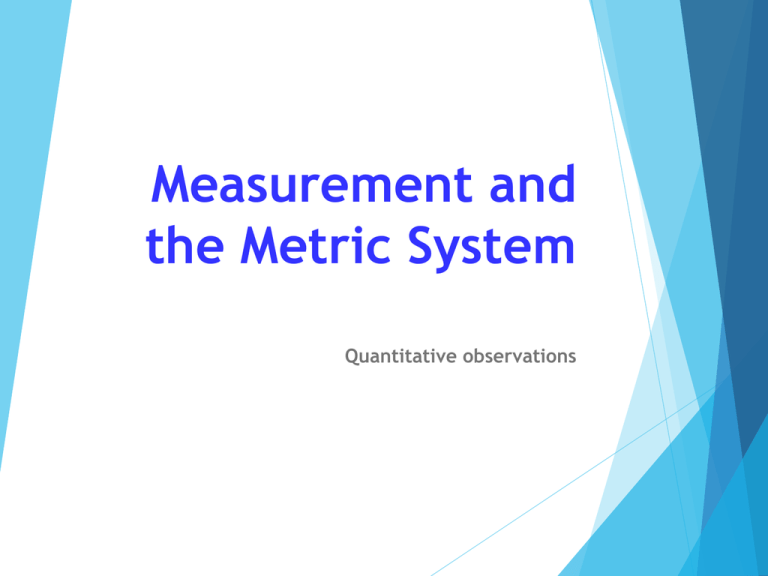
Measurement and the Metric System Quantitative observations Measurement Fundamental Direct measurement Indirect Derived measurement quantities Calculations Density Heat quantities energy Rules for Significant Measurements One place past the smallest calibration Indicates where uncertainty is Communicate instrument precision of the Protocols for deriving quantities Multiplication and division Addition and subtraction Rounding values Metric System Developed in France in 1795 Revised and called International System of Measurements (SI) in 1960 Based on units of 10 SI Base Units Quantity symbol Length SI base unit Meter Mass gram g Temperature Time Kelvin Celsius Second K oC s Liquid volume Liter L Amount of substance Mole mol m Memorize these !!!!! * “unit” refers to “base unit” 1 Kilo = 1 x 103 units 1Giga(G) = 1 x 109 units 1 Hecto = 1 x 102 units 1Mega(M) = 1 x 106units 1 Deka = 1 x 101 units 1 x 106 Micro(µ) = 1 unit Basic unit = 1 1 x 109 Nano(n) = 1 unit 1 x 101 deci (d) = 1 unit 1 x 1012 Pico(p) = 1 unit 1 x 102 centi (c)= 1 unit 1 x 103 milli(m) = 1 unit Conversions Practice Density Amount of matter per unit volume Water: Iron: Lead 1.000 g/ ml at 25C 7.87 g/cm3 11.3 g/cm3 Density is calculated by: D = mass volume Density Density is the amount of matter in a given space (volume) D = mass volume Density Measuring liquid volume Volume displacement Density Measuring solid volume Cube = length x width x height 2 Cylinder = V =πr h Density Ex: A solid displaces 45.67 ml of water and has a mass of 98.5 grams. Calculate its density. Is it a block of lead? Density practice Specific gravity Comparison of the ratio of the density of a substance to the density of liquid water at 4C (1.00g/ml) Temperature Scales Temperature is the measure of the average kinetic energy of a system. Implies molecular motion Celsius temperature Kelvin temperature Temperature Scales Fahrenheit Celsius Kelvin Water Boils Water Freezes Molecular Motion Stops 212oF 100oC 373 K 32oF 0o C 273 K -460oF -273oC 0 K (absolute zero) Converting between Temperature Scales Fahrenheit and Celsius: oC = 5/9 (oF-32) oF = (9/5 x oC)+32 Ex.What is the Celsius value for 60.0oF? oC = 5/9(60-32) oC = 5/9(28) oC = 15.55 oC =15.6 From Celsius to Kelvin: oC K = + 273 Ex.80.0oC would be what value on the Kelvin scale? K = 80 + K = 353 273 Heat and Specific Heat Heat is the flow of thermal energy in a system Heat flows from hotter to cooler Ice cubes! Heat can flow into or out of a system Heat and Specific Heat Heat transfer that causes temperature changes simply change in KINETIC ENERGY Heat transfer that causes phase changes imply change in POTENTIAL ENERGY The Joule Metric unit of energy 4.18 joules raises 1.00g of water 1C. This is the SPECIFIC HEAT OF WATER! Percent Composition When you see %, think…… Part X 100 = % Whole Percent Composition percent by mass % composition = Mass of element x 100% mass of compound Terms to review Fundamental and derived quantities Precision and accuracy Matter Mass Volume Density Significant Figures % composition Scientific notation Metric system Dimensional analysis

![Temperature Notes [9/22/2015]](http://s3.studylib.net/store/data/006907012_1-3fc2d93efdacd086a05519765259a482-300x300.png)

